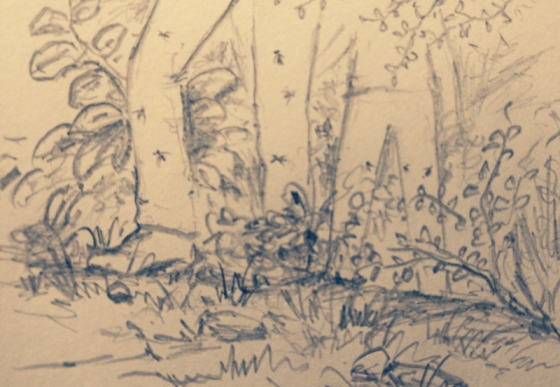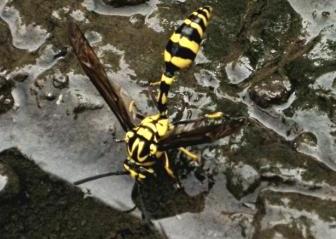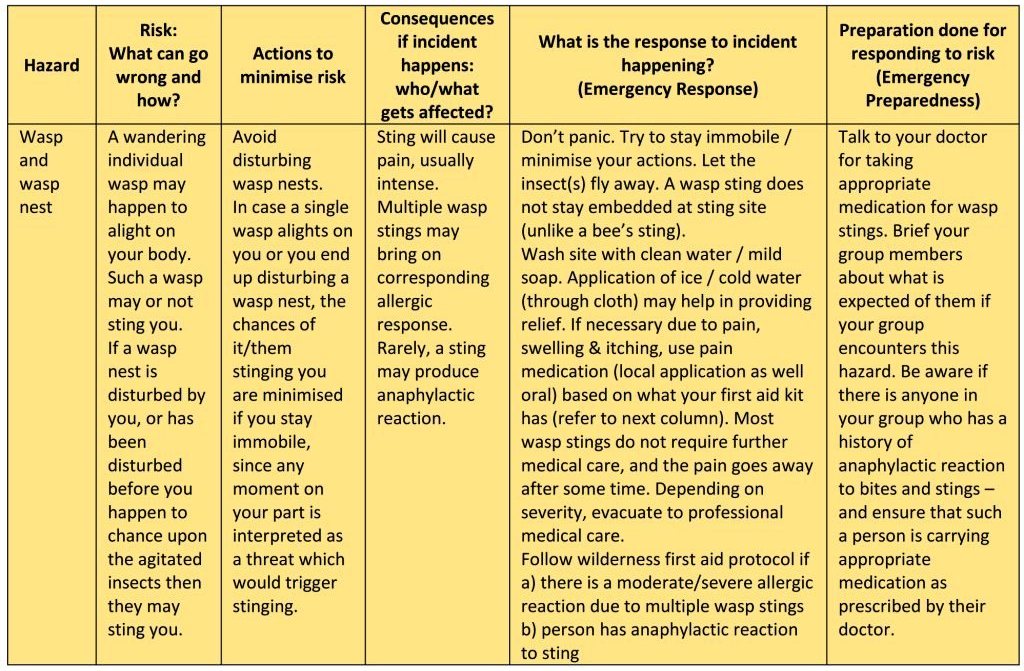* And some wasps we did upset… – Meghan Pandit *
Imagine walking into shrubbery and disturbing a wasp nest, and you coming to know about it only when the tiny insects swarm around your legs! It happened to me when I was walking in the woods surrounding our hometown along with my son who must have been ten or eleven at that time. I often wander off-trail and so we were wearing long trousers in anticipation of walking through grasses and other plant life. We chanced upon a crab that scuttled off behind a stone so we left the trail to go have a closer look at it. While passing through a couple of small bushes we disturbed a wasp nest located somewhere in their foliage. The creatures that emerged from their home were small but identifiable as wasps. I froze and asked my son to do the same, telling him that as long as we stood motionless we would not be perceived as a threat and they won’t sting us. So there we stood, trying not to move a muscle, while the winged wonders crawled around on trouser legs. Eventually they started going away and soon we were left alone. In the wilderness first aid courses that I teach this is what we advocate in the matter of bees and wasps – to not move since any movement from the creature that has disturbed them is perceived as a threat and then they go into fighting mode.

Like most of us, I too knew about wasps because they build nests in and around human dwellings and also because I had got stung a couple a times as a child – the remarkable pain ensures a never-fading memory! And then I was lucky to come across a book written by Niko Tinbergen (Dr. Nikolaas Tinbergen, Nobel Laureate and one of the founders of modern ethology, the study of animal behaviour). It introduced me to the incredible world of insects where the kind of things that happen defies belief. I have referred to wasps as ‘winged wonders’, and that is an understatement if there ever was one. The little I know about these small life forms as a layperson is enough for me to marvel at their strange world that goes almost unnoticed by us humans. The sting of a wasp (at least of the one that Niko Tinbergen was studying) is one of the engineering miracles of the animal world. It is sheathed in its own scabbard which opens up into individual leaves so the sting can be pushed out to do its job. And for some species that job is quite a macabre one. Females of some wasp species go for a prey that they paralyse with a sting, carry it to a nest and lay an egg on it. Hence, the wasp-larva that emerges gets fresh meat which does not fight back, and the prey is eaten alive. The stinging operation can be quite an undertaking. There are wasps, for instance, that go for beetles. So the female wasp has to first wrestle the beetle into submission, straddle it, bend it to expose the vulnerable spot between two sections of its protective exoskeleton, and then insert the sting to delicately locate the exact spot where the neurotoxin is to be injected in to the ganglia – insect-brain – of the unfortunate beetle. The chemistry of the various neurotoxins is very diverse, complex, and accurately ‘formulated’ specifically in each such species of wasp. After reading that book it was my dream to actually spot some action of a wasp in battle with its prey. My sightings? Three till now! Two are worth recounting. Once, in the Himalaya, I saw some frantic struggle happening in the dust right in front of me on the trail. My mind leaped to Dr. T’s book with a desperate hope! And sure enough, there it was, a brawl between a wasp and a spider! Finally I saw the spider get free and scurry off while the wasp flew away. I wondered if it was an unsuccessful hunt or the spider was going to go groggy after a few steps only to be carried away later to its gruesome fate. The second sighting was on a property on the banks of Ganga. On a lawn, I saw an insect-like life form in lumbering flight. Something about it struck me as odd. And lo! It was a wasp carrying a grasshopper more than double its size! After landing at a spot the wasp dragged its paralysed prey into a hole hidden in the grass. I immediately parked myself down in the lawn to watch further developments. The wasp emerged after some time, very businesslike, and flew off. Only to return with another grasshopper! Down another hole, and the meal for the next member of her brood was ready!

Every time I do this, i.e., park myself to watch insect life in action, I remember what Dr. T wrote about his experiences in that book. He used to sit waiting for a wasp to emerge from a hole in the ground after having deposited its prey and egg in it and run after it as it flew off in search of its next prey. He also spent hours sitting on the ground to see how wasps find a nest prepared in advance, shifting landmarks around it, changing the configuration of stones and fallen branches around it, etc. and then waiting to see how a wasp reacted to such changes. Once, construction workers nearby spotted this gentleman spend hours sitting on the ground doing nothing only to periodically get up and run around erratically and then return to the same spot again to sit doing nothing. They obviously could not see the wasps that Dr. T was watching and chasing, so they called up the police to report a poor man who seemed to have lost his senses!
Back to my walk with my son…
Back home after our little jaunt in the hills, I pestered my son to write about his ‘encounter’ because it was pretty significant that we had not been stung by a single wasp and I wanted to encourage the habit of writing in him. He finally got tired of my hounding him, went off in a huff to sit on a window sill, and wrote the following in one sitting.
Poem by Me
The trip started at the start of noon,
We started and we reached the hills soon,
We decided not to go to our stream,
But to visit the clouds like floating cream.
It had rained the previous day,
In its own fashion, on its own way,
Making the trees blossom with green,
Making the forest denser than it had usually been.
The temple stairs took some fun away,
The forest restored it with trees and clay,
The sunlight through the gaps of leaves,
Was like it had passed through many sieves.
We thought that the path was blocked,
But it only was covered with leaves together flocked,
Through many a slippery stone we went,
And more than below, the path was bent.
On natural steps we climbed up,
And heard the water tip-tup,
Falling down the foliage,
With no hurry, in many a age.
We made our way and reached the cliff,
Not at all feeling tired and stiff,
We saw our home from up there,
Not only our home, but a person here or there.
Soon the clouds covered us full,
We went higher with a push and pull,
To feel the droplets around us,
We heard the wind hussing a huss.
And some wasps we did upset,
Which put us in their debt,
All ‘cause of a jolly crab,
This is the way to damagers nature will stab.
We sought our downwards path,
Sought for what nature hath,
We reached the wet temple stairs again,
Which, of all, proved to be the worst pain.
– Meghan Pandit

For my post on my son’s sighting a python on one of his jaunts, click here.

Written with subtle humour, which also reflects in the poem by the son.
Interesting to learn about how accurate the sting of the Wasps are. Even more interesting is the keenness to observe such matters.